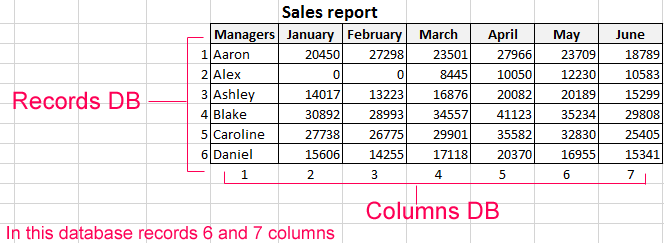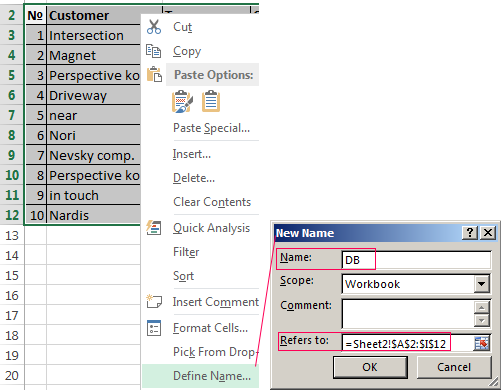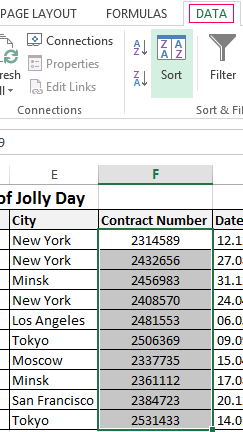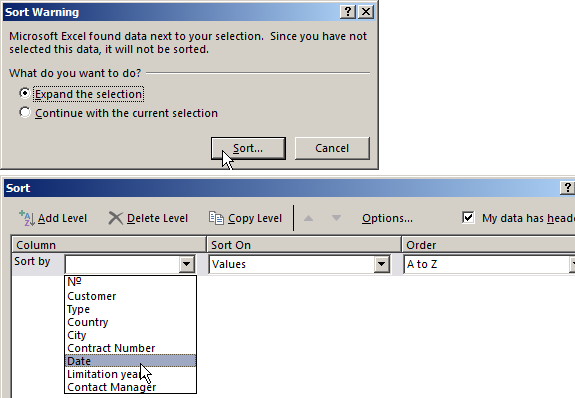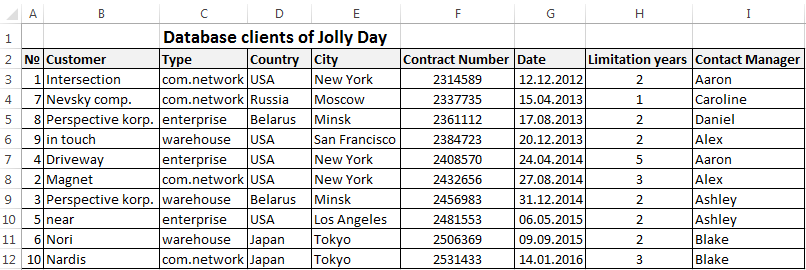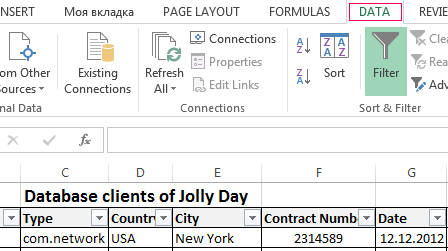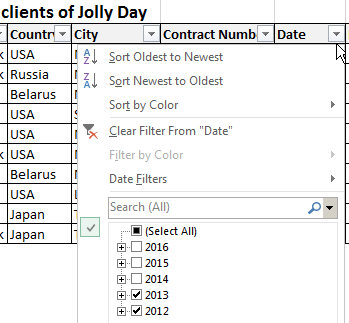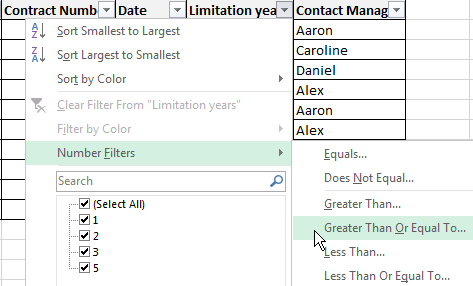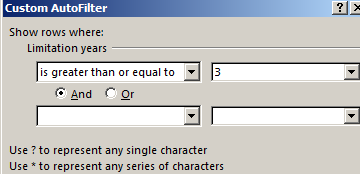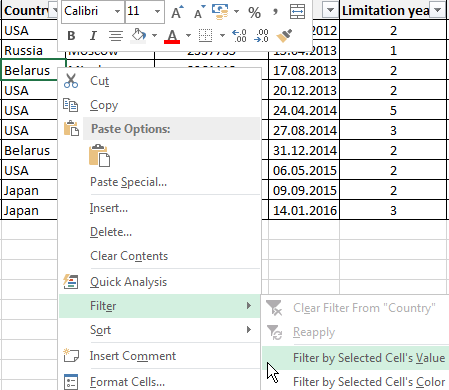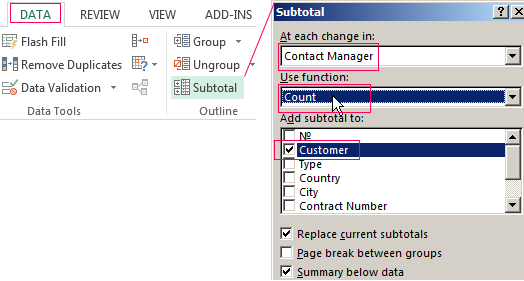Many users are actively using Excel to generate reports for their subsequent editing. Reports are using for easy viewing of information and a complete control over data management during working with the program.
Table is the interface of the workspace of the program. A relational database structures the information in the rows and columns. Despite the fact that the standard package MS Office has a standalone application for creating and maintaining databases named Microsoft Access, users are actively using Microsoft Excel for the same purpose. After all program features allow you to: sort; format; filter; edit; organize and structure the information.
That is all that you need for working with databases. The only caveat: the Excel program is a versatile analytical tool that is more suitable for complex calculations, computations, sorting, and even for storage structured data, but in small amounts (no more than one million records in the same table, in the 2010 version).
Database Structure — Excel table
Database — a data set distributed in rows and columns for easily searching, organizing and editing. How to make the database in Excel?
All information in the database is contained in the records and fields:
- Record is database (DB) line, which includes information about one object.
- Field is the column in the database that contains information of the same type about all objects.
- Records and database fields correspond to the rows and columns of a standard Microsoft Excel spreadsheet.
If you know how to do a simple table, then creating a database will not be difficult.
Creating DB in Excel: step by step instructions
Step by step to create a database in Excel. Our challenge is to form a client database. For several years, the company has several dozens of regular customers. It is necessary to monitor the contract term, the areas of cooperation and to know contacts, data communications, etc.
How to create a customer database in Excel:
- Enter the name of the database field (column headings).
- Enter data into the database. We are keeping order in the format of the cells. If it is a numerical format so it should be the same numerical format in the entire column. Data are entered in the same way as in a simple table. If the data in a certain cell is the sum on the values of other cells, then create formula.
- To use the database turn to tools «DATA».
- Assign the name of the database. Select the range of data — from the first to the last cell. Right mouse button — the name of the band. We give any name. Example — DB. Check that the range was correct.
The main work of information entering into the DB is made. For easy using this information it is necessary to pick out the needful information, filter and sort the data.
How to maintain a database in Excel
To simplify the search for data in the database, we’ll order them. Tool «Sort» is suitable for this purpose.
- Select the range you want to sort. For the purposes of our fictitious company the column «Date». Call the tool «Sort».
- Then system offers automatically expand the selected range. We agree. If we sort the data of only one column and the rest will leave in place so the information will be wrong. Then the menu will open parameters where we have to choose the options and sorting values.
The data distributed in the table by the term of the contract.
Now, the manager sees to whom it is time to renew the contract and with which companies we continue the partnership.
Database during the company’s activity is growing to epic proportions. Finding the right information is getting harder. To find specific text or numbers you can use:
By simultaneously pressing Ctrl + F or Shift + F5. «Find and Replace» search box appears.
Filtering the data
By filtering the data the program hides all the unnecessary information that user does not need. Data is in the table, but invisible. At any time, data can be recovered.
There are 2 filters which are often used In Excel:
- AutoFilter;
- filter on the selected range.
AutoFilter offers the user the option to choose from a pre-filtering list.
- On the «DATA» tab, click the button «Filter».
- Down arrows are appearing after clicking in the header of the table. They signal the inclusion of «AutoFilter».
- Click on the desired column direction to select a filter setting. In the drop-down list appears all the contents of the field. If you want to hide some elements reset the birds in front of them.
- Press «OK». In the example we hide clients who have concluded contracts in the past and the current year.
- To set a condition to filter the field type «Greater Than», «Less Than», «Equals», etc. values, select the command «Number Filters» in the filter list.
- If we want to see clients in a customer table whom we signed a contract for 3 years or more, enter the appropriate values in the AutoFilter menu.
Done!
Let’s experiment with the values filtered by the selected cells. For example, we need to leave the table only with those companies that operate in Belarus.
- Select the data with information which should remain prominent in the database. In our case, we find the column country — «РБ «. We click on the cell with right-click.
- Perform a sequence command: «Filter»–«Filter by Selected Cell’s Value». Done.
Sum can be found using different parameters if the database contains financial information:
- the sum of (summarize data);
- count (count the number of cells with numerical data);
- average (arithmetic mean count);
- maximum and minimum values in the selected range;
- product (the result of multiplying the data);
- standard deviation and variance of the sample.
Using the financial information in the database:
- Then the menu will open parameters where we have to choose the options and sorting values «Contact Manager».
- Select the database range. Go to the tab «DATA» — «Subtotal».
- Select the calculation settings In the dialog box.
Tools on the «DATA» tab allows to segment the DB. Sort information in terms with relevance to company goals. Isolation of purchasers of goods groups help to promote the marketing of the product.
Prepared sample templates for conducting client base segment:
- Template for manager which allows monitors the result of outgoing calls to customers download.
- The simplest template. Customer in Excel free template database download.
- Example database from this article download example.
Templates can be adjusted for your needs: reduce, expand, and edit.
As a business owner or project manager, you’re handling most things on your own at the beginning. Marketing, brand strategy, client communication—the list goes on! But there’s one thing you must have to scale: data management.
Databases aren’t just for big companies with hundreds or thousands of clients and products. It’s for anyone who wants to put manual work on autopilot, so they can track, retrieve, and protect all types of information.
If you’re using Excel as a temporary tool to import and export work, try ClickUp! You’ll have free access to actionable reports, change records, and powerful integrations—without the tech headache.
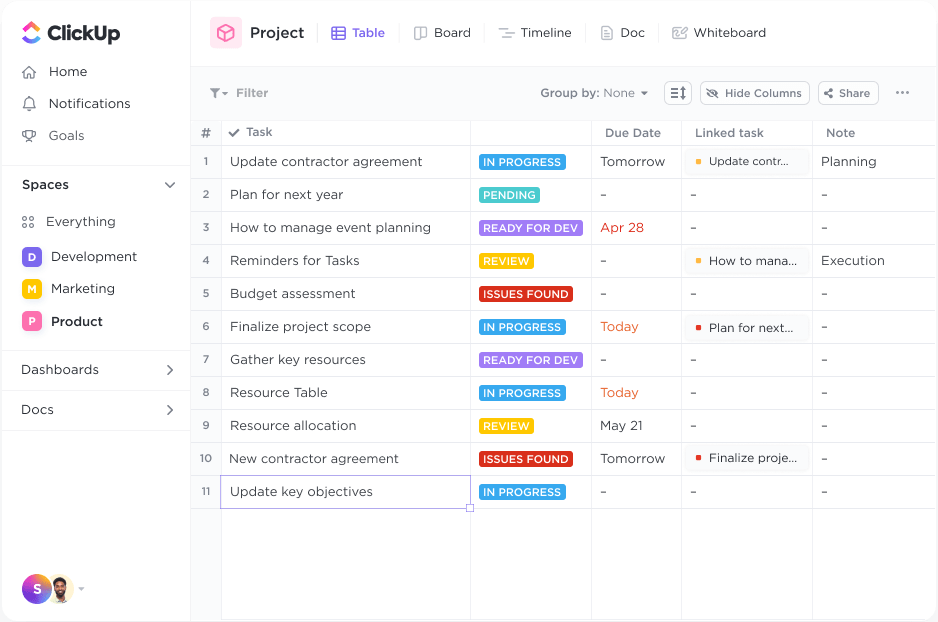
How to Create a Database in Excel (With Templates and Examples)
How to Create a Database in Excel
If you’ve struggled with creating or maintaining a database, you might feel every day is Day One because tracking is a labor-intense task in Excel.
So let’s learn how to create a database in Excel to sidestep the complexities and get to the good part: interacting with our data!
In this guide, we use Microsoft Word for Mac Version 16.54 to demonstrate a Client Management database. The features mentioned may look different if you’re on another platform or version.
Step 1: Set up a data spreadsheet framework
Open an Excel spreadsheet, place your cursor in the A1 cell, and type in your database title.
Go to the next row, and from left to right, use the Tab key to move through your blank database to add your column headers. Feel free to use this list as inspiration for your spreadsheet:
- Client Name
- Contact Name
- Health Level (drop down)
- Support Level (drop down)
- Engagement Level (drop down)
- Last Touchpoint
- NPS Score

Go back to your database title and highlight the first row up to the last column of your table. From the Home tab in the menu toolbar, click Merge & Center.

Step 2: Add or import data
You have the option to manually enter data or import data from an existing database using the External Data tab. Keep in mind you will have a database field for certain columns. Here’s another list for inspiration:
- Client Name
- Contact Name
- Health Level (drop down: At Churn Risk, Average, Very Good)
- Support Level (drop down: Gold, Silver)
- Engagement Level (drop down: High, Medium, Low)
- Last Touchpoint
- NPS Score

Bulk editing can be scary in Excel, so take this part slow!
Step 3: Convert your data into a table
Now let’s convert your data into a data model table!
Click inside any cell with data (avoid blank rows), and from the menu toolbar, go to Insert tab > Table. All the rows and columns with your data will be selected. We don’t want the title to be included in the table, so we have to manually highlight the table without the title. Then, click OK.

Step 4: Format the table
From the Table tab in the menu toolbar, choose any table design to fit your preference. Knowing where your table will be displayed will help you decide. Looking at a spreadsheet on a big screen in a conference room versus a 16-inch laptop makes all the difference to a person’s experience with the data!
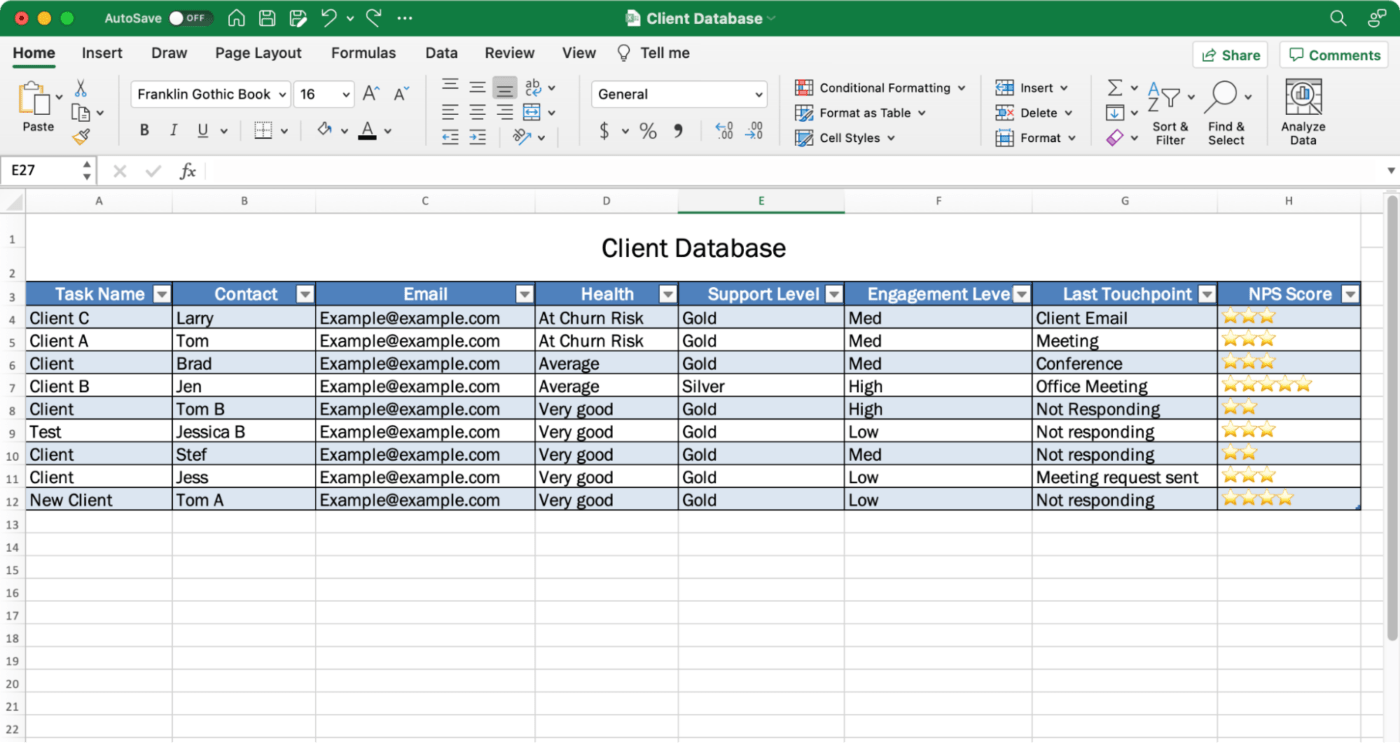
Step 5: Save your database spreadsheet
Finally, save your spreadsheet because you will have to come back and manually edit your database multiple times a day or week with the latest information. Set up Future You for success, so you don’t risk starting over!
Go to File > Save As > Name your database > click Save.
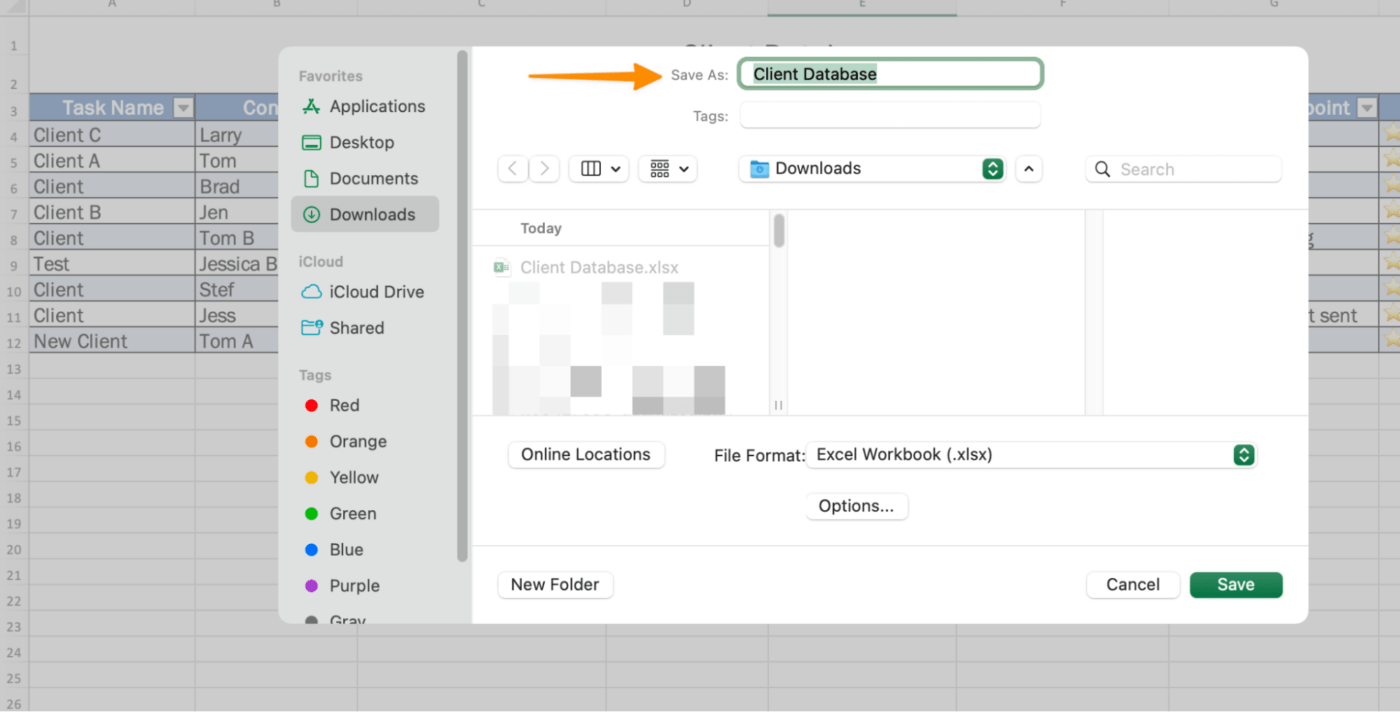
Free Database Templates
Check out these pre-made templates to jumpstart your database-building task!
1. Client Success Template by ClickUp
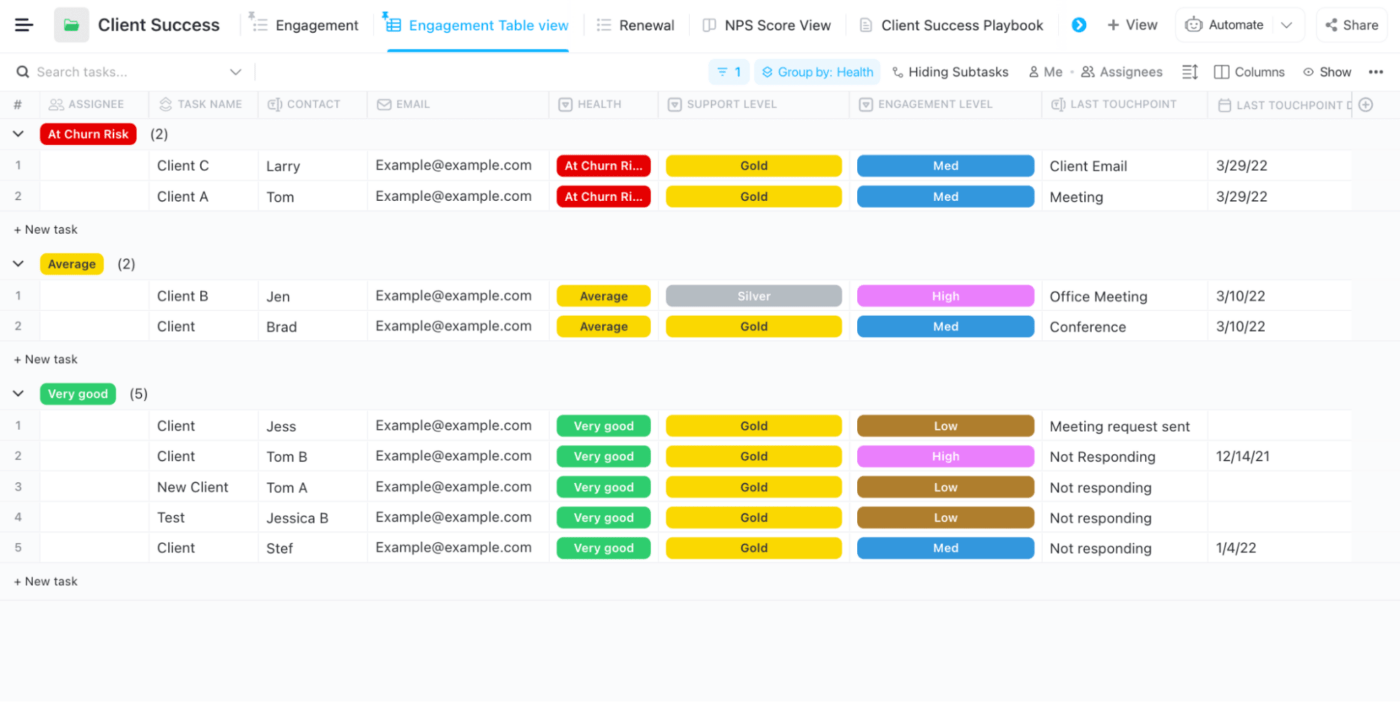
2. Excel’s Inventory List Template
3. Excel’s Warehouse Inventory Template
4. Excel’s Contact List Template
Related Resources:
- Excel Alternatives
- How to Create a Project Timeline in Excel
- How to Make a Calendar in Excel
- How to create Gantt charts in Excel
- How to create a Kanban board in Excel
- How to create a burndown chart in Excel
- How to create a flowchart in Excel
- How to Create an Org Chart in Excel
- How to Make a Graph in Excel
- How to Make a KPI Dashboard in Excel
How to Make a Database With ClickUp’s Table View
If you’re in a position where you’ll be using the database daily—meaning it’s an essential tool to get your work done—Excel won’t support your growth long-term.
Excel isn’t a database software built for the modern workplace. Workers are on-the-go and mobile-first. An Excel workflow sucks up time that should be spent making client connections and focusing on needle-moving tasks.
If you need a solution to bring project and client management under one roof, try ClickUp!
The process of building a simple but powerful database is easy in ClickUp. Import your work from almost anywhere with ClickUp’s free Excel and CSV import feature. Or vice versa! After you build a database in ClickUp, you can export it as an Excel or CSV file.
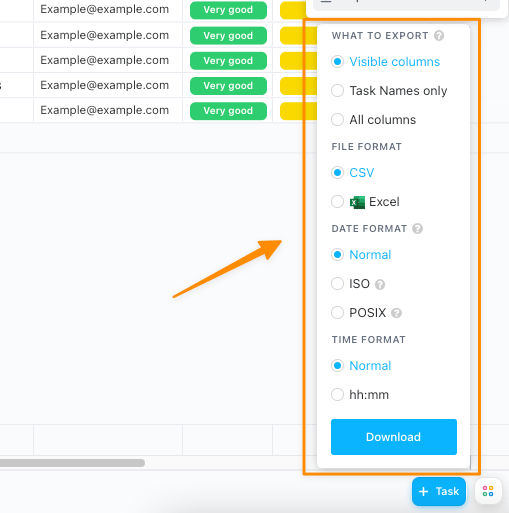
Is end-to-end security a non-negotiable term for your database tool? Same for ClickUp!
ClickUp has one of the strictest policies in our industry to ensure your data never gets into the hands of third parties. If you have a security question or concern, please feel free to ask us any time!
Using a Table view in ClickUp is like using an Excel spreadsheet, only:
- Data organization possibilities are endless with ClickUp Custom Fields
- Advanced filtering options make searching for data and activity stress-free
- Tasks in ClickUp empower you to plan, organize, and collaborate on any project
- Native or third-party integrations in ClickUp connect your favorite tools together
- Formatting options take fewer clicks to view only the data you need right away

There’s a stocked library of free Sales and CRM ClickUp templates for you to play in a digital sandbox with data examples if you want to see the potential of ClickUp—or get a few database ideas for your own.
We hope you feel more comfortable in the database-building process. You have other options than Excel to move your business closer to your goals.
303
303 people found this article helpful
How to Create a Database in Excel
Track contacts, collections, and other data
Updated on January 30, 2021
What to Know
- Enter data in the cells in columns and rows to create a basic database.
- If using headers, enter them into the first cell in each column.
- Do not leave any rows blank within the database.
This article explains how to create a database in Excel for Microsoft 365, Excel 2019, Excel 2016, Excel 2013, Excel 2010, Excel for Mac, Excel for Android, and Excel Online.
Enter the Data
The basic format for storing data in an Excel database is a table. Once a table has been created, use Excel’s data tools to search, sort, and filter records in the database to find specific information.
To follow along with this tutorial, enter the data as it is shown in the image above.
Enter the Student IDs Quickly
- Type the first two ID’s, ST348-245 and ST348-246, into cells A5 and A6, respectively.
- Highlight the two ID’s to select them.
- Drag the fill handle to cell A13.
The rest of the Student ID’s are entered into cells A6 to A13 correctly.
Enter Data Correctly
When entering the data, it is important to ensure that it is entered correctly. Other than row 2 between the spreadsheet title and the column headings, do not leave any other blank rows when entering your data. Also, make sure that you don’t leave any empty cells.
Data errors caused by incorrect data entry are the source of many problems related to data management. If the data is entered correctly initially, the program is more likely to give you back the results you want.
Rows Are Records
Each row of data in a database is known as a record. When entering records, keep these guidelines in mind:
- Do not leave any blank rows in the table. This includes not leaving a blank row between the column headings and the first row of data.
- A record must contain data about only one specific item.
- A record must also contain all the data in the database about that item. There can’t be information about an item in more than one row.
Columns Are Fields
While rows in an Excel database are referred to as records, the columns are known as fields. Each column needs a heading to identify the data it contains. These headings are called field names.
- Field names are used to ensure that the data for each record is entered in the same sequence.
- Data in a column must be entered using the same format. If you start entering numbers as digits (such as 10 or 20), keep it up. Don’t change partway through and begin entering numbers as words (such as ten or twenty). Be consistent.
- The table must not contain any blank columns.
Create the Table
Once the data has been entered, it can be converted into a table. To convert data into a table:
- Highlight the cells A3 to E13 in the worksheet.
- Select the Home tab.
- Select Format as Table to open the drop-down menu.
- Choose the blue Table Style Medium 9 option to open the Format as Table dialog box.
- While the dialog box is open, cells A3 to E13 on the worksheet are surrounded by a dotted line.
- If the dotted line surrounds the correct range of cells, select OK in the Format as Table dialog box.
- If the dotted line does not surround the correct range of cells, highlight the correct range in the worksheet and then select OK in the Format as Table dialog box.
Drop-down arrows are added beside each field name, and the table rows are formatted in alternating light and dark blue.
Use the Database Tools
Once you have created the database, use the tools located under the drop-down arrows beside each field name to sort or filter your data.
Sort Data
- Select the drop-down arrow next to the Last Name field.
- Select Sort A to Z to sort the database alphabetically.
- Once sorted, Graham J. is the first record in the table, and Wilson R is the last.
Filter Data
- Select the drop-down arrow next to the Program field.
- Select the checkbox next to Select All to clear all check boxes.
- Select the checkbox next to Business to add a check mark to the box.
- Select OK.
- Only two students, G. Thompson and F. Smith are visible because they are the only two students enrolled in the business program.
- To show all records, select the drop-down arrow next to the Program field and select Clear Filter from «Program.»
Expand the Database
To add additional records to your database:
- Place your mouse pointer over the small dot in the bottom right-hand corner of the table.
- The mouse pointer changes into a two-headed arrow.
- Press and hold the right mouse button and drag the pointer down to add a blank row to the bottom of the database.
- Add the following data to this new row:
Cell A14: ST348-255
Cell B14: Christopher
Cell C14: A.
Cell D14: 22
Cell E14: Science
Complete the Database Formatting
- Highlight cells A1 to E1 in the worksheet.
- Select Home.
- Select Merge and Center to center the title.
- Select Fill Color to open the fill color drop-down list.
- Choose Blue, Accent 1 from the list to change the background color in cells A1 to E1 to dark blue.
- Select Font Color to open the font color drop-down list.
- Choose White from the list to change the text color in cells A1 to E1 to white.
- Highlight cells A2 to E2 in the worksheet.
- Select Fill Color to open the fill color drop-down list.
- Choose Blue, Accent 1, Lighter 80 from the list to change the background color in cells A2 to E2 to light blue.
- Highlight cells A4 to E14 in the worksheet.
- Select Center to center align the text in cells A14 to E14.
Database Functions
Syntax: Dfunction(Database_arr , Field_str|num , Criteria_arr)
Where Dfunction is one of the following:
- DAVERAGE
- DCOUNT
- DCOUNTA
- DGET
- DMAX
- DMIN
- DPRODUCT
- DSTDEV
- DSTDEVP
- DSUM
- DVAR
- DVARP
Type: Database
Database functions are convenient when Google Sheets is used to maintain structured data, like a database. Each database function, Dfunction, computes the corresponding function on a subset of a cell range regarded as a database table. Database functions take three arguments:
- Database_arr is a range, an embedded array, or an array generated by an array expression. It is structured so that each row after Row 1 is a database record, and each column is a database field. Row 1 contains the labels for each field.
- Field_str|num indicates which column (field) contains the values to be averaged. This can be expressed as either the field name (text string) or the column number, where the left-most column would be represented as 1.
- Criteria_arr is a range, an embedded array, or an array generated by an array expression. It is structured such that the first row contains the field name(s) to which the criterion (criteria) will be applied, and subsequent rows contain the conditional test(s).
The first row in Criteria specifies field names. Every other row in Criteria represents a filter, a set of restrictions on the corresponding fields. Restrictions are described using Query-by-Example notation and include a value to match or a comparison operator followed by a comparison value. Examples of restrictions are: «Chocolate», «42», «>= 42», and «<> 42». An empty cell means no restriction on the corresponding field.
A filter matches a database row if all the filter restrictions (the restrictions in the filter’s row) are met. A database row (a record) satisfies Criteria if at least one filter matches it. A field name may appear more than once in the Criteria range to allow multiple restrictions that apply simultaneously (for example, temperature >= 65 and temperature <= 82).
DGET is the only database function that doesn’t aggregate values. DGET returns the value of the field specified in the second argument (similarly to a VLOOKUP) only when exactly one record matches Criteria; otherwise, it returns an error indicating no matches or multiple matches.
Thanks for letting us know!
Get the Latest Tech News Delivered Every Day
Subscribe

